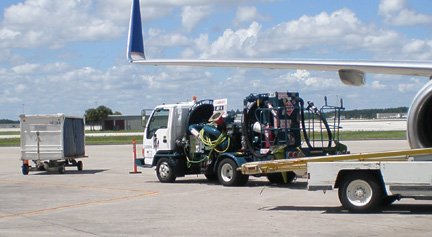Fueling
A number of things are going on to get your flight ready for departure, fueling your aircraft is probably one of the most important!
The flight dispatcher initially figures out the quantity needed for your flight. This is covered in
Flight Plan. After the Captain agrees with the amount(or adds some more), a fuel service form (fuel slip) is issued for the flight. Fueling is usually contracted to another company who receives this slip. The person doing the actual fueling is called the fueler. He hooks up his truck to the aircraft, usually under the wing. He can then pressure-fuel the aircraft. Many airports also have underground pipes that run to the gates, so that the aviation fuel can be from these pipes instead of a truck for fuel delivery.
He electrically grounds the pump and truck with a line usually connected to the metal on the landing gear. Fuel is then pumped to the amount of pounds required and is read by gauges on the wing and repeating gauges in the cockpit. Each aircraft type usually has several different fuel tanks to pump into. These include wing tanks, center tank(s), and auxiliary tank(s). While each aircraft type has it's own fuel load limitations, generally the wing tanks are filled first. If additional quantity is needed, the center tank(s) is filled,and then the auxiliary tank(s). These limitations might also include restrictions such as; if there is fuel remaining in the center tank (say more then 1000 pounds), then the wing tanks must be full.

Fueling Truck
After he is finished, the fueler fills out the fuel slip in triplicate and signs the bottom of the slip. The pilot's copy (pink in color) is then brought up to the cockpit by the fueler, or if he sees one of the pilots on the "walk-around" (in another section to come!) he hands it to him. The information on this slip includes the flight number, the aircraft number, and the date. In the main body of the slip is the starting, required, and ending fuel for the flight. These fuel figures are in gallons and must be converted to pounds by the pilots for backup verification.
This can be either be done manually or entered into the onboard computer. A conversion factor used for gallons to pounds is 6.7 pounds per gallon, this is the standard aviation fuel density. Fuel required is compared to the fuel gauges and the fuel slip. Any discrepancies must be resolved before the flight departs. This fuel slip is one of the paperwork items that your pilots need before the main door is closed.
Fueling back to My Airline Flight